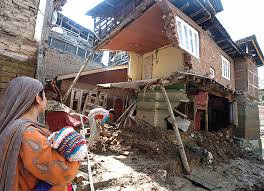Hamidullah Dar
 As I finished my day’s job at the desk on September 6 evening last year, I headed for waiting vehicle to rush to my rented accommodation at Rajbagh. As we drove on Zero Bridge, Jhelum waters were kissing the upper brims of the river banks. It was a frightful sight, made more menacing by the night hours and the flurry of emergent activities going on all around. The level of water was at its devastating high as any breach could prove disastrous for almost half of Srinagar city.
As I finished my day’s job at the desk on September 6 evening last year, I headed for waiting vehicle to rush to my rented accommodation at Rajbagh. As we drove on Zero Bridge, Jhelum waters were kissing the upper brims of the river banks. It was a frightful sight, made more menacing by the night hours and the flurry of emergent activities going on all around. The level of water was at its devastating high as any breach could prove disastrous for almost half of Srinagar city.
The scene at Aramwari Rajbagh was mixed one with those from main Rajbagh whose houses were lying precariously too low to face the water fury, enjoying the worry and apprehensions of the residents of comparatively elevated areas. The haughtiness of the well off Rajbagh residents was at its worst display, as they least cared for what was in store for them that materialized just after few hours.
I was wandering here and there, assessing escape options in case situation took ugly turn. For last two days, I had lost contact with my family at Muniwar village in Islamabad district. And at that time, water had almost encircled our house and the level was swelling. My family comprising my aged parents and minor children besides two sisters and my wife had last called me up on September 4 and expressed their helplessness. They had pleaded for my presence at home, but I somehow thought it would pass off without creating any worrying situation. But now, when I was looking at the ferocious display of flood waters, my apprehensions about their safety increased and I became extremely restless. The strength of my legs was gone and I could no longer roam along river bank to assess the situation.
As I was about to nibble at a loaf of bread, the front gate of the courtyard just in front of my rented accommodation shot open with a bang and a wave of water rushed in to hit the house. Cries and wails emanated from every room with the tenants (mostly from flood-free areas) crying helplessly and pleading for help. However, soon other residents of the locality joined the menacing course as water entered every house and courtyard within no time. The level of the water was increasing alarmingly and people just got time to save themselves, but not their belongings.
Everybody was on the road that earlier had been a bund. It was like doomsday as everyone was busy in saving himself—leaving for safer places in mini buses, Sumos and anything that could ply to safety. However, only a fraction of people could make it to safer places in vehicles as the breaches in banks of Jhelum had let in water from all sides and closed the escape routes completely. Now it was weather fury and helpless people. The battle for survival had started as stranded people started thinking of survival tactics. I could manage to reach the road strip, located at a comparatively safer elevation with several concrete hotels edging its sides. For the complete night, I along with another tenant, Abid, wandered on the 100-metre long road strip that finally submerged at 3.00 am on September 7. Its submergence was the confirmation of my worst fears that the deluge is going to create new record of death and destruction in Kashmir.
We took refuge in a hotel where already some families had taken shelter. I sat in a chair staring at the menacing waters that rushed in with a vengeance. As my mind settled a little bit, I recollected the words, last uttered by my youngest son Muhammad Nouman, pleading me to come home as he was fearing that our house would collapse by flood waters. A stream of tears rolled down my cheeks for the first time. After ensuring my safety in a hotel, my thoughts were roaming around my family in a deluged village in Islamabad. There was no way to communicate with them. My apprehensions were growing when I heard a thud outside the hotel. I rushed out to see a house had collapsed and there was no trace of it as water level was about two-storey high. There were wails, cries and moans all around. Numerous people were trapped in their houses or hotels in Rajbagh with water occupying two stories of the buildings.
I had seen floods right from my childhood as my village, Muniwar is located on the banks of Sandran Nallah, a tributary of Jhelum. But I had not seen the volume of helplessness that I was witnessing in Rajbagh. However, the resilience of the people took a happy turn when locals and some volunteers ferried boats and started rescue operation for those, trapped in houses that were surrounded by 25-feet high water level. However, at around 12 noon on September 7, a boat carrying a family capsized some 20-feet from the anchorage site, resulting in drowning of two children. I did not see the scene like others did who were on the spot, however, I reached the spot within four minutes and saw the wildly mourning mother from Shopian. It was a heart-wrenching sight with almost every eye dripping tears for the loss of two lives.
But the incident did not discourage the rescue activities with more and more trapped people being brought to hotels, situated at safer elevation along the road. The exhibition of brotherhood and selflessness was at its peak during those trying times as people were sharing anything that could help others to survive or minimise their tribulations. However, as the water level raised more and more, the rescue work started dwindling as it was dangerous to set on any rescue mission for the rescuer as well as for rescued. However, helicopters started rescue operation from a hotel just opposite to where we were putting up. They made about 10 sorties and every time 20 to 25 people were airlifted to safer places. It is an irony that barring two Kashmiris, one an old lady and other an ailing man, all were either tourists or non-locals. The locals were straight away refused airlift which infuriated them but they could do nothing.
With no hope of being rescued, the trapped people, mostly women, children and elderly people started weeping at a higher pitch that was high enough to move any heart. In the evening of September 7, there were no eatables available for us as all shops were submerged now and whatever they had, was sold earlier. Abid and I had just one bottle of water to arrange with. We spent the night in the hotel, almost empty-stomach.
Next day, some youth broke open shutter of a godown and brought many boxes of bananas. It was a unique display of brotherhood as the bananas were first served to the tourists who were putting up in a nearby hotel. After that secretariat employees from Jammu were given two bananas each and lastly we Kashmiris were fed with one banana each.
There was some relief as the water level had started to recede, but it was almost imperceptible and quite against the speed with which it had risen the previous day. On September 9, water level had receded to the extent that the road strip near Modern Hospital was almost clear of water. We left for our rented accommodation to prepare some food. We had to wade through chest-high water to reach the building. It was like being in a houseboat as water encircled every building in the locality. On this day, choppers dropped some eatables but that was not enough to feed the stranded people.
On September 10, I finally decided to head for home. After morning prayers, I left Rajbagh at 7.00 am and reached Gupkar gate of Badami Bagh cantonment at around 9.00 am after much detouring through Dalgate and Drugjan. We were not allowed to pass through the cantonment area till 4.30 pm. It was a sea of worried people waiting outside the gate and anxious to meet their loved ones back at their home. I too was a drop of that sea which intermittently turned into wave at the gate, but was repulsed by the Army men guarding the gate. Many people shouted at soldiers that this was our land and why they were not being allowed to pass through the area when it was the only way to connect the city with South Kashmir. However, at last and after precautionary measures, we were bussed through the cantonment area and dropped at the other end. From here, it was not proverbial but real uphill task as we had to foot several kilometres after climbing hillock at Pandrethan to reach Zewan. Here also BSF people frisked everybody and then permitted to proceed ahead. At last it was CRPF camp wherefrom we exited the ‘No Entry Zones’ and started walking for Lethpora. The area was untouched by the flood fury and it looked quite nice to see any area, not visited by destruction. People all along were cooperative enough to provide travelers with eatables and cold drinks. I reached Barsoo village near Awantipora at around 10.30 pm and stayed there for the night.
Next day at 10.30 I reached my village, Muniwar. It was a reassuring sight to meet some neighbours outside the village but I was apprehensive that my house definitely had collapsed and I was now shelterless. As I neared my residence, more and more people wished and hugged me. They had heard that Rajbagh has suffered the worst and accordingly, they were asking me a barrage of questions. I somehow reached my Mohalla and saw my wife. She also saw me. I stopped but she did not. She came rushing towards me, smiling. However, when she reached near me, tears welled up in her eyes. Next moment she cried, saying ‘we had almost lost hope of your survival’. We went to our home where our old house stood as it used to be. I thanked Allah as I was not shelterless like tens of thousands who lost their home and hearth in the floods.





